Zum Loggen des Earthcaches mache ein Foto von Dir/Deinem GPS und einem Zettel mit eurem Nicknamen und dem Datum, an dem ihr hier ward vor der Infotafel oder dem Vulkanausschnitt (siehe Beispielfotos) laut Guidelineänderung vom 10.06.2019 ist dieser "Fotobeweis" jetzt wieder erlaubt. Das Grundstück ist leider eingezäunt, das zweite Foto habe ich durch den Zaun gemacht - bei euch darf er dann natürlich drauf zu sehen sein ;)
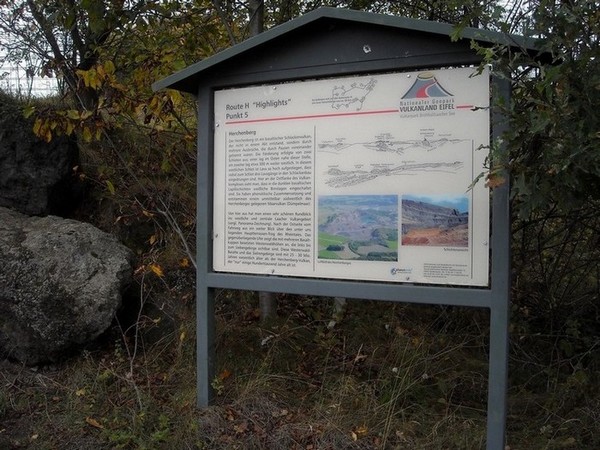
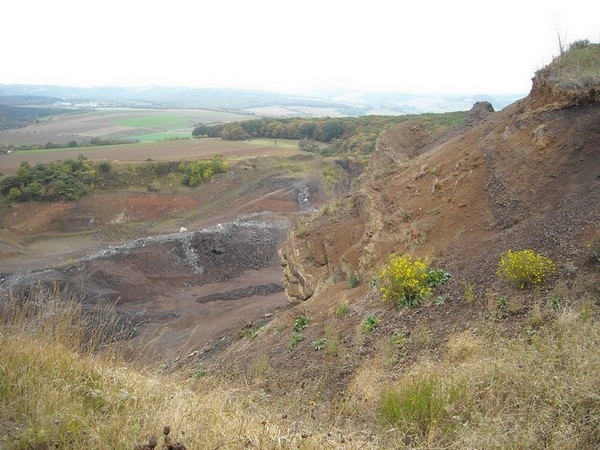
Zusätzlich sende mir eine Mail mit den Antworten auf folgende Fragen, loggen kannst Du direkt, ich melde mich, wenn etwas falsch ist oder fehlt:
1) Was ist passiert als die Lava im westlichen Schlot hoch aufstieg?
2) Wie alt ist der Herchenberg ca?
3) Was ist der "Koloss von Oberlützingen"?
4) ans Foto denken. ;)
Zum Herchenberg: Seine Lage ist nordwestlich von Burgbrohl. Es gibt beim Herschenbergvulkan zwei Ausbruchzentren, ein südöstlicher und ein nordwestlicher Ausbruch. Im südöstlichen Ausbruchszentrum kann man zwei Ausbruchsphasen unterscheiden, die durch eine Ruhephase getrennt sind.
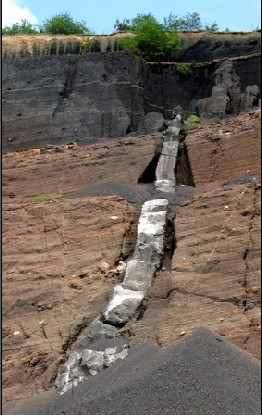
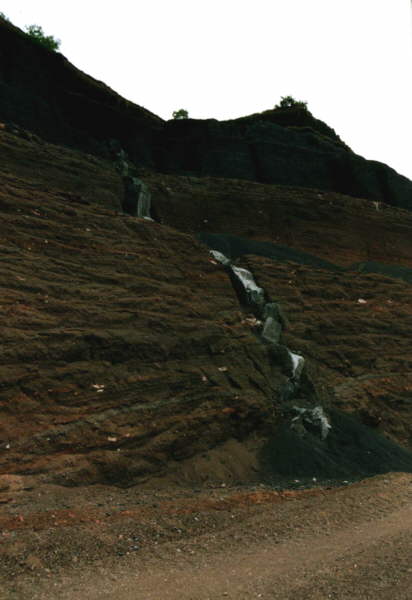
Die erste Ausbruchsphase lässt sich erkennen an den steil in den Berg einfallenden, dunkel geschichteten Schlacken, die über Kieseloolith-Schottern, verkieselten Sanden, tertiärem Ton und devonischem Schiefer liegen. Es folgte eine längere Ruhepause in der sich Löss und anschließend Wehrer Bims über die vulkanischen Auswurmassen legte. Danach muss eine intensive Bodenbildung stattgefunden haben. Es konnte festgestellt werden, dass die Bodenbildung in keiner Kaltzeit erfolgte und das hier zeitweise ein Kratensee verhanden war. Die Schichtenfolge in der fossilen Kratenmulde dokumentiert eine Kaltzeit und im Anschluss eine Warmzeit. Über den Humusablagerungen der Kratermulde liegen Löss und Basalttuffe von unbekannter Herkunft, die in einer zweiten Kaltzeit abgelagert wurden.
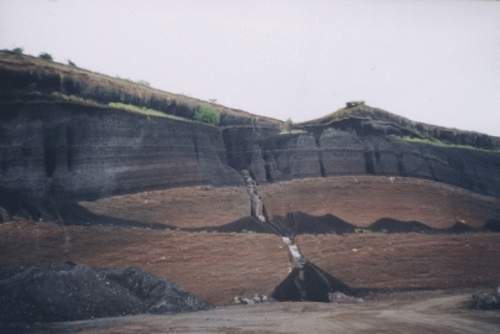
In der zweiten Ausbruchsphase wurden wahrscheinlich Teile der ersten Ausbruchsphase weggesprengt. Wie man am Profil im Tagebau entnehmen kann wurden zuerst grobe Tuffe und anschließend wechsellagernd Lapillituffe und Schlacken gefördert. Über diesen Schichten liegen mehrere Meter Kugeltuffe mit im Schlot gerundeten Basaltkugeln und darüber liegen grobe Schlacken. Über diesen Vulkaniden liegt Lös und Bimstuffe vom Kahlenbergtyp.
Am südwesthang sind steilstehende Gänge, die kreuzförmig vom Förderzentrum ausgehen freigelegt worden. Es handelt sich um Melilith-Nephelinit. Im Zentrum vom Herchenberg befinden sich im Schlackentuff mehrere dezimeterbreite Spalten im Schlackentuff. Diese Spalten sind mit einem Gemenge von Löß, Kieseloolithgeröllen, Devonfragmenten, tertiären Tonen und Sanden und Bimslapilli ausgefüllt.
Die erste Ausbruchphase ist wahrscheinlich in die viertletzte Kalteiszeit zu stellen. Die zweite Ausbruchphaseliegt wahrscheinlich zwischen der drittletzten und zweitletzten Kalzeiszeit.
Quelle: (visit link)
To log the Earthcache take a photo of you or your gps with a sign that shows your nickname and the date when you have been here in front of the information panel or the volcano (see example photos) - the parcel is fenced unforunately, the second picture was taken from through the fence - your picture can show it certainly. According to the guideline change from 06/10/2019 it is once again allowed to ask for this picture as a proof that you have been there. ;)


Send me an e-mail with the answers to the following questions, you can log directly, i´ll write you an info, if there is something missing or wrong:
1) What does happen as the lava climbed up in the western chimney stack?
2) How old is the Herchenberg?
3) What means "Koloss von Oberlützingen"?
4) don´t forget the picture ;)
The Herchenberg is a basaltic tuff and clincer volcano. He lies northwest of Burgbrohl. There are two break out centers, a southeastern and a northwestern outbreak at the Herschenbergvulcan.Two outbreak phases can be distinguished in the southeastern outbreak center. These were separated by a resting phase.
 " />
" />
The first outbreak phase can be recognized by the clinkers which are steeply invading the mountain and in dark clothes stratified which lie over Kieseloolith gravels, sands, tertiary clay and devonic slate. A longer break followed, the Löss and Wehrer pumice stone moved over the volcanic ones. After that an intensive floor formation must have taken place. It could be stated, that the floor formation wasn't carried out in any cold time and that a Kratensea was available here at times. The layer consequence in the fossil Kratenmulde documents a cold time and a warm time in the connection. Löss and basalt tuffs of an obscure origin which were deposited in a second cold time lie over the humus deposits of the crater hollow.

Parts of the first outbreak phase were probably blown up away in the second outbreak phase. How at the profile in the open-cast mining one can rough tuffs and following became change storing Lapillituffe and clinkers promoted first take. Some meters of ball tuffs are above these layers with basalt balls rounded in the chimney stack and coarse clinkers are over it. And pumice stone tuffs of the Kahlenbergtyp lies solve about this Vulkaniden.
At the southwest slope steep stationary walks are, which cross-shapedly starts out from the promoting center been exposed. It is Melilith-Nephelinit. Several decimeter wide columns are in the center of the Herchenberg in the clinker tuff in the clinker tuff. These columns are filled out by Löß, Kieseloolithgeröllen, Devonfragmenten, tertiary clays and sands and Bimslapilli with a mixture. The first end break phase has to be put for wahscheinlich in the fourth to the last cold ice age. The second outbreak lies probably between the third to the last and last but one cold time.
Quelle: (visit link)
Opencaching: OC9822